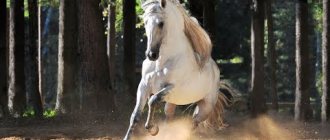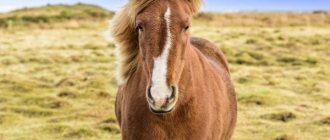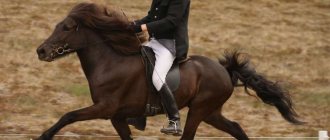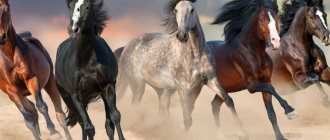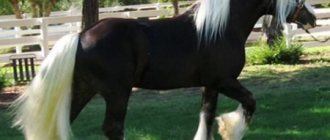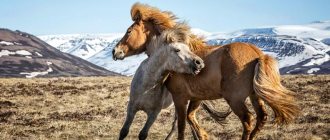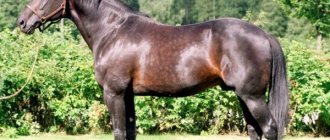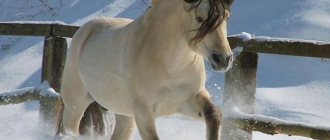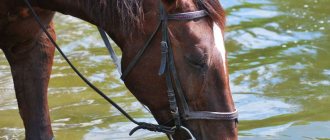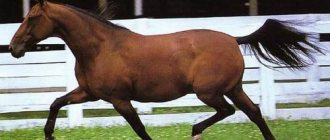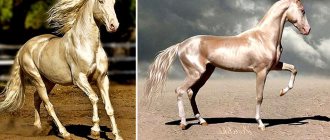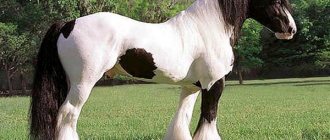The American Trotter is a breed of horse considered to be the fastest. These horses played a special role in the formation of domestic, Russian trotters.
Black horse runs
The use of the American Trotter in horse racing
Bay horse of the American Trotter breed
Black horse grazing
Bay horse
Black horse runs
Russian trotter black
Young horse standing
History of origin
This horse was bred in America through complex reproductive crossbreeding. Thoroughbred riding horses were used in breeding. Exactly like other breeds. It should be noted that the most important role in the process of formation of the American breed was played by the purebred riding stallion, who was the owner of the gray color of the horse.
He took an active part in entire seasons of various races, winning eight starts out of the fourteen that took place. For twenty years, from April 1788, after he was brought to Philadelphia, he was used in the USA as a breeding stallion. Moreover, this horse, to be fair, was crossed only with purebred special fillies. Over twenty years of breeding use, with its help, a special branch of trotters was obtained, which in terms of their trotting qualities and agility had no equal.
Stallion Messenger
Character
In the selection process, a large number of different breed lines of horses were used, each of which assumed an individual character, and it was not always positive. Thus, the English horses used in work were distinguished by their willfulness and complexity of training.
But despite this, breeders still managed to eliminate the shortcomings of some of the original breeds. As a result, the temperament of the standardbred breed turned out to be calm, flexible, and balanced. Such animals unquestioningly listen to the owner and learn quickly; in addition, the animal behaves friendly and without aggression with other horses.
Characteristic
The American Trotter (Standardbred) horse breed is a distinct prize horse. Due to careful selection, based on only one main characteristic - horse agility - breeders were able to develop a breed of horses that had outstanding abilities for running in light carriages. American trotting horses of our time have the correct exterior and structure, but are quite large. They have a very strong constitution, and all muscles are well developed.
Good muscle development
Strong and dry limbs complement this wonderful “bouquet”. They have amazingly easy performance movements. American horses are obedient and durable. They are precocious. All perfect records were set with the help of horses three or four years old. Max Lobell became the one who holds the mile record among all existing trotters. And the animal was three years old, just like that.
The height of the American Trotter varies from 1.42 m to 1.63 m. Sometimes the horse can be taller. Height at the withers of a standardbred horse is 1.53–1.57 m, oblique body length is 1.54–1.58 m, chest girth is 1.7–1.85 m, pastern girth is 0.18–0.2 m.
However, often the animals are bay, red, black or dark bay. The animals are powerfully built, and somewhat less noble and harmonious than the English thoroughbred horse. In addition, trotters have a more extended torso. And the legs are much shorter.
Red suit
Advantages and disadvantages of the breed
The American Trotter is widely distributed throughout the world. Until now, the main stock of horses is concentrated in the USA, but they are also successfully bred in Canada, Australia, New Zealand, and Denmark. Of course, horses owe such a high popularity to a wide range of advantages, the main ones among which are the following:
- agility;
- endurance;
- resistance to many diseases characteristic of horses;
- calm, balanced disposition;
- high reproductive rates;
- longevity of horses.
The American Trotter is calm and hardy
The precocity of animals also allows us to expand the list. Almost all world records held by American standardbreds were set by stallions aged 3 to 4 years. Already at the age of 3, the horse is fully formed and ready to participate in sports competitions.
Another important point is that most of these trotters can use 4 types of gaits. For most horses, only 3 of them are available:
- Normal step.
- Gallop.
- Lynx.
But since Canadian pacers also participated in the development of this type of horse, their heirs can also amble. To take advantage of this opportunity, animal owners have developed special belts that limit trotting. Ambling competitions among American Standardbreds are rarely held due to the high risk of injury.
Flaws
Among the shortcomings of the breed, their ordinary and rough appearance initially stood out. Many breeders have focused their attention on this problem. But over time, the exceptional agility of the animals nevertheless replaced the exterior nuance and it was crossed out from the list of shortcomings.
Also, although the animal is distinguished by its unpretentiousness, certain conditions are required to obtain maximum results from such horses and for their well-being. They need to be provided with proper housing, as well as special training that allows them to maintain the stallion’s tone.
The standardbred horse breed is rightfully called the best trotter in the world. These animals hold most of the world speed records in light sled racing. They are still used in this sport today. In addition, American Trotters are also often used to improve other breed lines, which further increases their value. It is possible to achieve significant results from an animal only if it is provided with proper housing conditions and training.
Breeding standardbreds
When breeding standardbreds, the growing process and quality training conducted by professionals are very important. No less important are the mandatory agility test and, of course, selection.
In the United States, foals are born from the best sires at numerous stud farms. There they are raised until they are one and a half years old, after which they are sold.
The preparation of horses for hippodrome trials is carried out by experienced trainers. It is carried out at special training depots. An American Trotting Horse that reaches two years of age must cover a 1609 m track in a minimum of 2 minutes 15 seconds. The pacers must show even greater agility. If the race results are unsatisfactory, the horse will not be used on the racecourse. In this way, the required level of agility of the breed is maintained.
Currently, American trotters are divided into two lines depending on the gait with which they move. The first class includes pacers, and the second class includes trotters. In each of them there were sires who produced high-quality offspring.
In the line of pacers these are Direct, Abbedale and Nible Hanover. And among trotters, these are considered to be Volomite, Scotland and Axworthy.
Standardbreds often differ greatly from each other in body type and height. This variability is due to the fact that selection was often carried out only for agility, and exterior, for example, was not particularly important.
Breed overview
WEIGHT: from 400 to 600 kilograms.
HEIGHT: from 140-170 centimeters.
BODY TYPE: thick mane and tail; muscular legs; deep chest; somewhat reminiscent of a thoroughbred horse.
BEST FOR: Owners and riders of all levels.
How long do they live: from 25 to 30 years.
American Trotters in Russia
In Russia at the very beginning of the 20th century, the Orlov trotting horses, which had never known defeat, were distinguished by their extraordinary agility and speed, at the peak of their popularity. Their fame resounded throughout Europe. It was in those days that standardbred horses were first brought to Russia from America specifically for competitions with Oryol trotters. This name was unusual for the Russian ear, so they were soon renamed American trotters. They immediately became fierce competitors of the Oryol trotting horses, which had no equal in all of Europe. American trotters in Russia took first place at any distance.
Breeding the Russian Trotter
Because of the triumph produced by standardbred horses, Russian horse breeders had the idea to improve the agility of Oryol trotters by crossing them with American ones. This is how the process of breeding the Russian trotter began. The most sensational stallions, Alvin, Bob Douglas and General H, as well as some other representatives of the standardbred breed, were crossed with Oryol trotting horses. Subsequently, they themselves and the resulting mestizos became the progenitors of the Russian trotting horse.
Stallion Gumbletonian
Second delivery
For quite a long period of time, from the Civil War until the 60s, standardbreds were not purchased. The need for them appeared when Soviet horse breeders decided to increase the agility of the Russian trotter. And in 1966, the second import of standardbred horses was carried out. At first, the horses purchased by Soviet horse breeders lived at the Zlynsky stud farm, then they moved to the Maikop GZK, located much to the south. Since it was soon converted into a stud farm, some of the standardbreds located there were transported to the Kuban GZK, which was created especially for them.
Among the American trotters purchased in the 60s was Low Hanover, which, more than the others, contributed to the improvement of the characteristics of Russian trotting horses. From him the largest number of trotters were born, who had really high agility.
Race at the hippodrome
Third delivery
However, the next generation of descendants of famous stallions was unable to maintain agility at the required level, and horse breeders decided to buy another batch of standardbreds. The third import of American trotters to Russia was more successful. At that time, many truly valuable horses were brought from the USA. These stallions were not only crossed with Russian trotters, but were also used to breed standardbreds. The most famous of them was Reprise. He was also recognized as the best sire, since this bay stallion produced more than a hundred excellent trotters of class 2.05. It was from him and the daughter of Low Hannover Seal, brought from the USA in the 60s, that Sorrento was born, recognized as the best American trotter produced in Russia. Also famous descendants of Reprise are Grotto and Nut.
Gallant Pro was brought to the USSR with it. Born from him and his daughter Reprise of Rhetoric, the dark bay stallion Rangout can compete in fame with Sorrento. For four years he was first in terms of the amount of prize money received for the competition. At the Central Moscow Hippodrome, Rangout had no equal. There he won almost all significant prizes. Rangout’s significant achievement is the record he set while participating in the “Elite Prize”. He completed the distance in 1 minute 59.1 seconds. Moreover, the time in which Rangout covered the 2400 m long track is considered his absolute record. It was 3 minutes 02.0 seconds.
American Standardbred Horse Colors
American Standardbred horses come in a variety of colors, including bay, brown, black, chestnut, gray and other solid colors. They lack white markings on the face and legs such as blazers and stockings. And there are no stains on them.
Unique Characteristics of the American Standardbred Breed
There are two different types of standardbred breeds: trotters and pacers. Trotters have a diagonal gait, meaning their front left leg and back right leg step in unison (along with their front right and back left).
Pacers move their legs to one side in unison (for example, left front step to left back step). The speed of pacers in harness racing is faster than that of trotters. This species outnumbers trotters on the track.
Riding a pacer is a great way to loosen up a stiff back at dirt speed. Pacers can also be encouraged to trot for a spectacular and enjoyable ride.
Similarities between Russian and American trotters
The similarity between Russian and American trotters born in Russia is simply amazing. In essence, they are one breed and are quite inferior to standardbreds from America and European countries in terms of agility, although in Russia they participate in competitions on equal terms, while the Oryol breeds compete exclusively with each other.
In Russia, the progenitor of all American manufacturers is Speedy Crown. From him was born Prakas, a stallion who set world records. Now in Russia the American trotter is bred in more than 15 horse farms.
Currently, Lemur, Prelate and Pharaoh are recognized as the best American trotters born in Russia. The lemur already at the age of three years showed an absolute record. He covered the 1600 m long track in 1 minute 59.2 seconds. The prelate successfully competed in races both at home and abroad. He distinguished himself at competitions in Germany, where he did it in 2 minutes at a distance of 1600 m. In Russia, he covered the 2400 m track in 3 minutes 3.0 seconds. Pharaoh is the owner of many prizes and records. The time it took him to cover a distance of 1600 m was 2 minutes 0.4 seconds.
But no matter what, the American trotting horse is recognized throughout the world as the standard of speed and agility, and so far it has not been possible to develop a more advanced breed.
Common Health and Behavior Problems in the American Standardbred Horse
representatives of the breed do not have health problems. But former racehorses are more likely to eventually develop problems related to general wear and tear, including arthritis and leg problems.
In terms of behavior, these horses are usually calm and friendly, and enjoy human company. But it may take some time for a former racehorse to relearn general riding. This task is likely to be difficult for someone with little experience with horses.
LiveInternetLiveInternet
In Scandinavia, Belgium, Denmark, Holland, Germany, the Baltics, Italy, Hungary, Romania, Russia, North America (USA, Canada), Australia and New Zealand, trotter racing is popular, generating huge betting fees. The racetracks of these continents are filled with trotters and pacers of the American breed. The American Trotter breed (trotting horse of the American standardbred breed) was formed in the USA at the end of the 18th-19th centuries. The ancestor is Hambletonian X, born in 1849. Source material: thoroughbred horse, Norfolk trotter, to a lesser extent - Arabian, Morgshan, local horses.
During its formation, there was a strict selection for agility, so the breed turned out to be the fastest in the world; the absolute world record at a distance of 1609 m (one mile) is 1 min 51 s (Pine Chip, 1994, USA). The breed is not calibrated in terms of height: the range is from 155 to 170 cm in height at the withers. Colors - all the most common, but mostly bay of various shades
The breed was developed through complex reproductive crossbreeding: selection included Thoroughbred Saddlebred, Norfolk Trotter and Arabian horses, as well as local breeds and Canadian pacers. A major role in the formation of the breed was played by the purebred gray riding stallion Messenger, born in 1780. Over 20 years of breeding use, a special branch of trotters was obtained from him, which in terms of agility and trotting qualities had no equal. The gray purebred stallion Messenger, bred in 1785 from England, was of exceptionally great importance. His role in the creation of the American trotter can be equated to the role of Smetanka in the creation of the Oryol trotter. A gray-bred descendant of the Darley Arab, Messenger was born in 1780 and competed in flat racing for three seasons, winning eight of fourteen events.
Exported to Philadelphia in May, 1788, he was an active sire for twenty years, first covering thoroughbreds and, when racing was banned in New York, mares of all other breeds. Some of his descendants performed well in flat racing, but he earned his lasting fame by producing good trotting horses (not so much in direct offspring as in subsequent generations). Of the European trotting breeds, the Norfolk and Dutch were the most important. Of the Norfolk, the stallion Bellefounder, born in 1815, had a special influence. From the daughter of Bellefounder and the grandson of Messenger, Abdallah, born in 1823, in 1849, the founder of the American trotters, Hambletonian X, was born, whose importance in the formation of the breed was no less than Barca 1st in the creation of the Oryol trotter. Hambletonian's four sons, George Wilkes, Dictator, Happy Medium and Electener, became the founders of the breeding lines that compete in virtually every harness trotting race held in the United States today. Hambletonian was the result of an internal cross between Charles Kent Mayor and Messenger, and on his mother’s side, whose father was Belfounder, was descended from the famous Norfolk trotter Old Sheils. In addition to European breeds, Barbary, Canadian and some other breeds of horses were used to create the American trotter. Initially, the breeding of the American Trotter pursued the same goals as the breeding of the Oryol Trotter - obtaining a traveling draft horse. However, it soon began to be bred for racetrack racing, which was facilitated by the rapidly expanding network of racetracks and the growth of betting turnover. The organization of hippodrome business and the training of young stock for hippodrome trials in the United States quickly improved, and selection and selection in American horse breeding began to be carried out solely on the basis of the agility shown by horses on hippodromes, without taking into account the exterior and type of build. The American trotter was created by various methods and in a huge number of horse breeding farms, not united in their work by any specific goal, i.e., breeding a horse of any specific type. The stallions, outstanding for their agility, were widely used in mating and left a large number of offspring. Thus, 1,330 foals were sired by Hambletonian X.
Pacers are horses of the same breed, running in a gait called ambling, and not trotting, that is, moving their legs at the same time to one side: right - left, right - left.
For horses that get confused while running, special belt fetters are put on their legs for clean ambling. Pacers run faster than trotters; the absolute world record for ambling at 1.09 m belongs to Kambest - 1 min 46.2 s (1993, USA).
There are three lines in the breed: Volomaita 2.03 1/4, born in 1926, which develops through his two grandchildren, first-class sports trotters and sires - Star's Pride 1.57.1 and Noble Victory 1.55 3/5; Scotland 1.59 1/4, born 1925, through his son the stallion Hoot Mon 2.00 and grandson Speedster 1.59 1/5, whose sons, grandsons and great-grandsons now dominate the racetracks of America; Axworthy 2.15 1/2, born 1892 The line continues through Floriken 1.57 2/5.
Standardbreds either amble (horizontally) or trot (diagonally). For a long time, the American trotter did not have access to the European continent, since it could not compete with the Oryol trotter in harness work, and as a sports horse it did not find a market due to the lack of trotting sports and hippodromes. Only in the 80s did it appear in Western Europe after the racing business had arisen and strengthened there under the influence of the Oryol trotter. Thus, the priority in creating a massive and at the same time quite playful trotter, equal in type and exterior, suitable for wide economic use, belongs to Russia. American trotters have always been smaller and poorer-boned than Orlov's; they are more likely to have such exterior defects as a shortened body, a short and sloping croup, the size of the front legs, clubfoot, and sabreed hind legs; More often than Oryol trotters, they have kurba, spar and other major defects and defects of the exterior. At the same time, they have a drier constitution, well-developed muscles, tendons and ligaments, and a straight topline, which cannot always be observed in the modern Oryol trotter. Currently, in the United States, the trotter is also bred exclusively for sporting purposes. Not only stallions and mares, but also geldings are allowed to race in America. At the same time, stallions that are difficult to train are often castrated with the express purpose of improving their temperament. Both trotters and pacers are equally allowed to race. All factory work in the USA is aimed at breeding a fast horse suitable for racetrack use at an early age. At 1-1.5 years of age, foals are sold from stud farms at auctions to specialized farms located primarily in the Southern States, where they undergo training. By the age of two, young horses enter the racetracks; the best of them at this age already show agility of 2.10-2.15 at 1600 m. Races are held at numerous hippodromes, and horses constantly wander throughout the country from one hippodrome to another during the season. In 1903, the first “minuteless” records for a mile (1600 m) were set in America: the gelding Mejor-Dilmer 1.59% and the mare Lou-Dillon 1.58%. By the end of 1945, in the United States there were already 46 trotters and 83 pacers of class 2.00 and faster at 1600 m. Of the 46 trotters on this list, there are 22 stallions, 15 mares and 9 geldings. Some horses show high agility both at the trot and at an amble. Long distance races - 3200, 4800 and 6400 m - are not very common in the USA, and the records for these distances are significantly inferior to the records of Oryol and Russian trotters.
Work on the reproduction of purebred American trotters is organized at the Maikop stud farm (Krasnodar Territory) and at the Kuban State Stables horse farm. At hippodromes, American trotters are tested together with Russian trotting horses. When recording them in the State Books, the sign “A” is placed after the individual number of the breeding horse.
FAMOUS HORSES: Greyhound. One of the most famous Standardbreds of all time, who did much to revive the waning interest in trotting in the 1930s, was a swift gray gelding named Greyhound, who in 1938 trotted one mile in a record time of 1 minute 55.25 seconds. , which lasted 31 years. Sorrento. The bay stallion, born in the Kuban State Conservatory in 1985 from Reprise and Sealy, became a real legend: he was the only Russian horse of the European level, capable of participating in the most prestigious prizes abroad on equal terms with world and European champions. His performances in the hands of Mikhail Kozlov at the hippodromes of Europe became a real sensation. In Finland, guests from Russia are still shown the stall where Sorrento stood. Sources;.https://horse-stamps.narod.ru/info/i-hor-amer-trot.htm
https://prohorses.forum2x2.ru/t43-topic
https://www.sudarrb.com/old/porod/images/s/standartbred.html
https://clubriding.ru/loshadi/37-amerikanskaya-rysistaya-loshad.htm
https://riding-ua.ru/?p=110
In pre-revolutionary Russia, the import of American trotters was stopped in 1914. After the Great October Socialist Revolution, not a single trotter was imported from America. But in the 1990s of the twentieth century, a number of stallions were imported from the USA, leaving a noticeable mark on the Russian trotting breed. The most famous and promising of them were Tamerlan, Sierra Cosmos (Axworthy line), Apex Hanover, Madrigal, Low Hanover, Manhattan, Reprise (Wolomite lines), Bill Hanover, Victorious Speed, Rugby's Star, Sir Scott, Wrestles Spirit, King Caunh, Doneraile, Galant Pro, Trotpix Parkway (Scotland – Rodney lines), Adios, Brat Hanover (Tzi Abbe lines). Currently, some stud farms in Russia raise American standardbred trotters.
The breed received the name “standardbred” due to the fact that, starting from 1879, the year of official recognition of the breed, the right to register horses in the register was conditioned by certain requirements (standards) of agility. These standards have changed from time to time. Until 1931, it was mandatory that trotters run a mile (1609 m) in 2 minutes 30 seconds and pacers in 2 minutes 25 seconds, regardless of their origin. After 1931, the main requirement for entry into the register was not the agility demonstrated in tests at the hippodrome, but the origin of the horse from the parents recorded in the register. In the pre-war period, these horses were called American trotters, but they became standardbreds after pacers, registered in the same societies, were also included in the breed.
